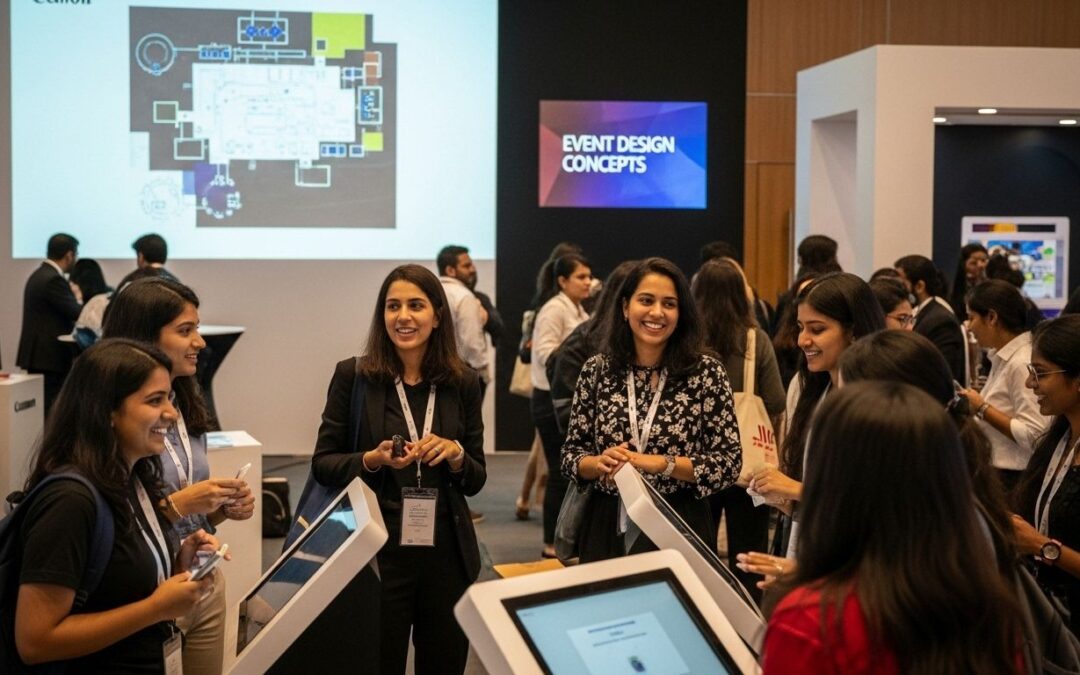Event design once meant picking colors and setting up chairs, but today it’s a whole new world where technology meets art and psychology. Suddenly you have multisensory spaces, real-time data, and experiences that feel custom-built for every guest. Get this. Creative layout strategies can increase audience participation, knowledge retention, and satisfaction by up to 47 percent. That kind of impact changes everything you thought you knew about successful events.
Table of Contents
- Understanding Event Design Concepts And Roles
- Essential Principles Of Creative Event Design
- Practical Steps To Develop Innovative Event Concepts
- Applying Event Design Concepts In Real-World Scenarios
Quick Summary
| Takeaway | Explanation |
|---|---|
| Event design is strategic architecture. | It requires planning and creative visualization to create immersive experiences that resonate with audiences. |
| Integrate multiple senses in design. | Successful events engage participants through sight, sound, touch, and technology for a cohesive emotional journey. |
| Develop flexible event concepts. | Concepts should evolve based on audience feedback and technological advancements for greater engagement. |
| Utilize technological tools for prototyping. | Advanced tools like VR and data analytics help create and refine event environments effectively. |
| Adapt designs to real-world contexts. | Implementing adaptive strategies is crucial to navigating dynamic environments and audience needs effectively. |
Understanding Event Design Concepts and Roles
Event design is a strategic discipline that transforms raw ideas into immersive experiences through meticulous planning, creative visualization, and precise execution. At its core, event design goes far beyond simple logistics—it represents a comprehensive approach to crafting memorable moments that resonate with audiences and achieve specific organizational objectives.
The Strategic Architecture of Event Design
Professional event design involves creating a holistic blueprint that integrates multiple dimensions of experience. According to EventMB, successful event design requires understanding complex interactions between spatial configurations, sensory experiences, emotional engagement, and technological integration. This means event designers are not just planners but strategic architects who orchestrate environments that tell compelling stories.
The contemporary event design professional must possess a multifaceted skill set. Event Industry Report highlights that modern event designers need expertise in visual aesthetics, psychological understanding of audience dynamics, technological proficiency, and strong communication skills. These professionals act as creative directors who translate abstract concepts into tangible experiences that connect deeply with participants.
Roles and Responsibilities in Event Design
Event design professionals operate across diverse roles that require specialized knowledge and creative problem solving. Key roles include:
To clarify the variety of specialized roles involved in modern event design, here’s a table summarizing key roles and their main responsibilities:
| Role | Primary Responsibilities |
|---|---|
| Creative Director | Develops the event’s conceptual framework and ensures overall cohesion |
| Experience Architect | Designs strategies for audience engagement and interaction flows |
| Technical Coordinator | Manages tech integration and production elements |
| Spatial Designer | Conceptualizes physical and virtual event environments |
- Creative Directors: Develop overarching conceptual frameworks for events, ensuring visual and experiential cohesion
- Experience Architects: Design precise audience engagement strategies and interaction flows
- Technical Coordinators: Manage technological integrations and production elements
- Spatial Designers: Conceptualize physical and virtual event environments
Each role contributes uniquely to creating immersive, meaningful event experiences. The comprehensive guide on professional event management provides deeper insights into these specialized career paths.

Understanding event design concepts requires recognizing that every detail matters. From color psychology to spatial arrangement, from technological integration to emotional storytelling, event designers craft experiences that transcend traditional boundaries of communication and engagement. Their work represents a sophisticated blend of art, psychology, and strategic planning—transforming ordinary gatherings into extraordinary moments of connection and impact.
Essential Principles of Creative Event Design
Creative event design transcends traditional planning by transforming spaces into dynamic, emotionally resonant experiences that engage participants on multiple sensory and psychological levels. The fundamental principles driving modern event design represent a sophisticated blend of strategic thinking, artistic vision, and technological innovation.
Spatial Storytelling and Experiential Architecture
Effective event design is fundamentally about narrative creation through physical and digital environments. Research from EventMB reveals that successful events craft immersive storylines where every spatial element contributes to a cohesive narrative arc. This means designing not just a physical space, but a journey that guides participants through carefully curated emotional and intellectual experiences.
According to a peer-reviewed study on event design impacts, innovative spatial arrangements significantly enhance participant engagement. The research demonstrates that creative layout strategies can increase audience interaction, knowledge retention, and overall event satisfaction by up to 47%.
Multisensory Design and Technological Integration
Contemporary event design principles emphasize creating holistic experiences that engage multiple senses simultaneously. This approach goes beyond visual aesthetics to incorporate sound, texture, temperature, and interactive technological elements. Designers now use advanced tools like augmented reality, interactive displays, and adaptive lighting to create dynamic, responsive environments.
- Sensory Mapping: Deliberately designing experiences that stimulate multiple sensory channels
- Technology Layering: Integrating digital and physical interaction points
- Emotional Resonance: Creating environments that evoke specific emotional responses
Our comprehensive guide to event management provides deeper insights into these advanced design strategies.
Ultimately, creative event design represents a sophisticated discipline that merges psychology, technology, and artistic vision. By understanding and implementing these principles, event designers can transform ordinary gatherings into extraordinary, memorable experiences that deeply connect with participants and achieve specific organizational objectives. The most successful designs are those that feel both intentional and effortlessly organic—creating moments of genuine human connection in increasingly digital and fragmented world.
Practical Steps to Develop Innovative Event Concepts
Developing innovative event concepts requires a strategic approach that combines creative thinking, systematic planning, and deep understanding of audience expectations. Professional event designers must move beyond traditional methodologies to create experiences that are both memorable and purposeful.
Conceptualization and Research Strategies
The initial phase of event concept development demands comprehensive research and audience analysis. Harvard Business Review suggests that successful event designers begin by conducting thorough market research, understanding demographic trends, and identifying emerging audience preferences. This involves collecting data through surveys, focus groups, and industry trend analysis to uncover unique insights that can drive innovative design.
Professional event strategists recommend a multi-dimensional approach to concept development. Event Industry Research Institute emphasizes the importance of creating flexible conceptual frameworks that can adapt to changing audience expectations and technological innovations. This means developing event concepts that are not just static plans but dynamic, responsive experiences that can evolve in real-time.
To make it easier to grasp the practical steps for developing innovative event concepts, here’s a table outlining the process and corresponding strategies discussed:
| Step | Description/Strategy |
|---|---|
| Conceptualization & Research | Conduct market research, survey audiences, analyze trends |
| Audience Analysis | Identify demographic trends and emerging preferences |
| Flexible Frameworks | Develop adaptable, dynamic concepts that evolve with audience needs |
| Digital Simulation | Use VR and 3D models to prototype event environments |
| Scenario Planning | Build and iterate multiple audience interaction scenarios |
| Predictive Analytics | Utilize data insights to anticipate and enhance engagement patterns |
Technological Integration and Creative Prototyping
Modern event concept development leverages advanced technological tools to transform abstract ideas into tangible experiences. Key strategies include:
- Digital Simulation: Using virtual reality and 3D modeling to prototype event environments
- Interactive Scenario Planning: Developing multiple design iterations with potential audience interaction scenarios
- Predictive Analytics: Utilizing data-driven insights to anticipate audience engagement patterns
Our comprehensive guide to event types offers additional insights into specialized event design approaches.
Innovative event concept development is not about creating perfect plans but about establishing flexible, responsive design frameworks. Successful designers understand that great events are living experiences that emerge through continuous iteration, audience feedback, and creative problem solving. By combining rigorous research, technological innovation, and a deep understanding of human interaction, event professionals can create transformative experiences that go beyond traditional expectations and create genuine moments of connection and engagement.
Applying Event Design Concepts in Real-World Scenarios
Translating event design concepts from theoretical frameworks into practical, impactful experiences requires strategic implementation and adaptive thinking. Real-world event scenarios demand a nuanced approach that balances creative vision with practical constraints and audience expectations.
Strategic Implementation and Contextual Adaptation
Harvard T.H. Chan School of Public Health highlights the critical importance of adaptive design strategies, especially in dynamic environments. Their research demonstrates how successful event designers must develop flexible frameworks that can rapidly respond to changing circumstances, technological shifts, and unexpected challenges.
Professional event designers recognize that theoretical concepts must be translated into actionable strategies. Research from the National Center for Biotechnology Information emphasizes the significance of data-driven decision making, suggesting that successful event design involves continuous feedback collection, iterative refinement, and precise audience engagement measurements.
Practical Application Frameworks
Effective real-world event design incorporates multiple strategic elements:
- Contextual Analysis: Understanding specific audience demographics and environmental constraints
- Technological Integration: Leveraging digital tools to enhance participant experience
- Flexible Design Methodology: Creating adaptable event structures that can evolve in real-time
Our comprehensive guide to event management provides deeper insights into practical implementation strategies.
Ultimately, applying event design concepts requires a sophisticated blend of creativity, technical expertise, and strategic thinking. Successful professionals understand that each event represents a unique ecosystem where design principles must be carefully calibrated to specific contexts. By maintaining a dynamic approach that prioritizes participant experience, technological innovation, and responsive design, event professionals can transform theoretical concepts into extraordinary, memorable experiences that resonate deeply with audiences and achieve specific organizational objectives.

Frequently Asked Questions
What is the role of a creative director in event design?
A creative director develops the event’s conceptual framework, ensuring visual and experiential cohesion throughout the event.
How can spatial storytelling enhance audience engagement?
Spatial storytelling creates immersive narratives through physical and digital environments, guiding participants through carefully curated emotional and intellectual experiences, thereby boosting engagement.
What are some key principles of multisensory design in events?
Key principles of multisensory design include sensory mapping, technology layering, and creating environments that evoke specific emotional responses to engage participants on multiple levels.
How should event concepts evolve over time?
Event concepts should evolve based on audience feedback and technological advancements, allowing designers to create dynamic and responsive experiences that maintain participant engagement.
Transform Event Design Theory Into Career-Defining Success
Struggling to turn modern event design concepts into real results? If you are feeling overwhelmed by the challenge of balancing spatial storytelling, multisensory experiences, and technological integration, you are not alone. Many aspiring and current event professionals discover that knowing the latest strategies is not enough. What you need is a powerful combination of practical skills, hands-on exposure, and guidance from true industry insiders. If you want to bridge the gap between event design concepts and in-demand expertise, start by exploring Event Management at team.i and discover how you can build the foundation for breakthrough events.

Do not let your passion and ideas go undeveloped. At team.i.org, you find specialized courses designed for real-world impact, backed by 23 years of experience and industry partnerships with leaders like DNA Entertainment Networks. With each program, you gain practical exposure and the opportunity to participate in live events. If you are ready to step confidently into the modern world of event design, start with the opportunities waiting for you on our Event Management page or get an overview of our industry-driven approach on the official site. Secure your future in this fast-growing field today.

